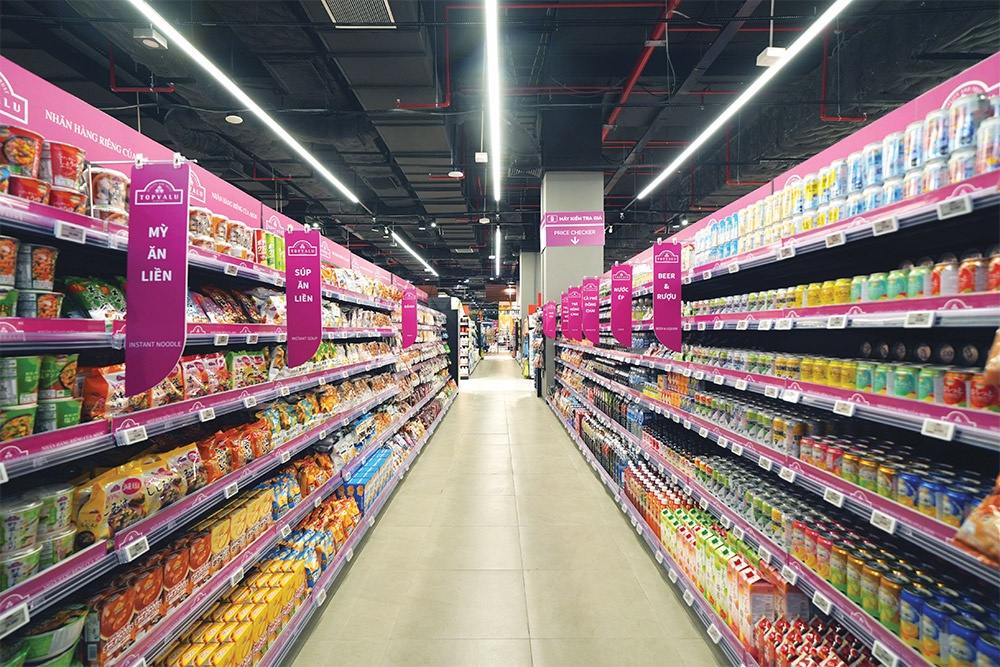Effective expansion tactics illustrate retail market health
 |
| Effective expansion tactics illustrate retail market health |
Last weekend, AEON Vietnam’s ninth department store opened in Hanoi, marking the Japanese retailer’s next step in its expansion strategy.
Furusawa Yasuyuki, general director of AEON Vietnam said, “In addition to focusing on developing large shopping malls to provide experiences and spaces for customers, we also focus on developing retail models of different scales near residential areas, and AEON Xuan Thuy is one of them,” he said.
After the pandemic, AEON Vietnam said its growth remained stable thanks to new strategies and initiatives. In 2024, the company accelerated the opening of new business locations with various models, including three department stores and supermarkets, supermarkets, and speciality stores.
This year, AEON will focus on strategies such as more store openings, developing products in Vietnam, and exporting, strengthening e-commerce and digital strategies, leveraging customer IDs through financial business and reinforcing training of local managers.
“We will focus on accelerating dominant store openings through multi-format rollout. Tan An shopping mall is expected to open by the end of the fiscal year, marking a significant milestone in our expansion in the Mekong Delta area,” Yasuyuki said.
According to Yasuyuki, the retailer plans to open 3-4 new super supermarkets in both the southern and northern regions of Vietnam in 2025, alongside medium and small supermarkets in the north, and speciality stores nationwide.
“The Vietnam market has maintained steady growth in line with our plans,” Yasuyuki said. “In the coming years, AEON remains focused on expanding market share and increasing customer quantity in Vietnam.”
According to the assessment of Vietnam’s consumption prospects from Tien Phong Securities, the size of Vietnam’s retail market in 2024 was estimated at more than $276 billion and is forecast to increase to $488 billion by 2029, an average growth rate of about 12 per cent.
In the race to increase market share, many retailers have opened new stores and developed more suitable models to optimise the customer experience.
In November alone, the domestic retail chain WinCommerce opened 44 more WinMart+ and Win stores, bringing the total number nationwide to nearly 4,000. The Win model in urban areas and WinMart+ in rural areas, which began in 2024, has helped WinCommerce reach the maximum number of different customer groups.
A series of WinMart supermarkets have been renovated and upgraded, in which in Hanoi alone, those in Truong Chinh, Dai La, Thai Thinh, and Ha Dong have switched to a modern design with convenient shopping space and diverse product categories. WinCommerce forecasts that the total number of physical stores of the chain will increase by 9 per cent by the end of 2025.
Meanwhile, Central Retail is investing about $1.45 billion in Vietnam between 2022 and 2027 to double the number of stores to 600, increasing its presence in nearly 60 localities nationwide.
Along with large supermarket models, Central Retail also developed the Mini Go! supermarket model to expand its business investment activities in Vietnam. In December, the retailer opened two new mini supermarkets in Thua Thien-Hue and Dong Thap provinces, bringing the total number of mini supermarkets owned by the group in Vietnam to 14.
According to the retail industry outlook report released on January 2 by MB Securities, the potential for modern retail in the medium and long term is still increasing thanks to increasing consumer income and increasing consumer demand for quality products. The application of AI and omnichannel has also helped retailers exploit the significant potential in this market.
“Modern retail models of big players such as AEON Mall and Go!, as well as smaller retail models such as Winmart+, have been successful thanks to competitive and effective sales strategies,” said the report.
Grocery retail chains such as WinCommerce recorded an impressive recovery in 2024 with average revenue increasing by 15 per cent, thanks to attracting customers from traditional markets.
According to the General Statistics Office, Vietnam’s total retail sales of goods and consumer services revenue in 2024 reached $266 billion, a 9 per cent increase. With the country’s GDP in 2024 estimated at $479 billion, the retail and consumer services sector accounted for about 55.5 per cent of GDP.
| Nguyen Anh Duc, chairman Vietnam Retailers Association
The market with a scale of more than $200 billion will be a fierce competition for retailers not only in terms of price but also in terms of increasing convenience, value, emotions and shopping experiences. To not fall behind, businesses need to anticipate consumer trends, take advantage of technology and innovate to meet the increasing needs of customers. A notable trend in the market is the strong transformation in the structure of retailers. In 2024, the structure of enterprises with foreign indirect investment and foreign-invested enterprises will account for more than two-thirds of total retail sales. This strongly suggests that the Vietnamese retail market is attractive. 2024 also witnessed a transformation between the proportion of modern retail and traditional retail when, for the first time post-pandemic, the proportion of traditional retail has dropped further, which is a change in trend. Before the pandemic, the proportion of modern retail was 24 per cent, after the pandemic it decreased to 18-19 per cent. In 2025, modern retail will increase to 25 per cent. In big cities such as Hanoi and Ho Chi Minh City, the proportion of modern retail accounts for 28-30 per cent, higher than in other cities and provinces. For large retailers, e-commerce retail revenue is constantly increasing. This is consistent with the general direction of digital development. Retailers have made appropriate transformations and expect to increase revenue from this in the future. Nguyen Cao Ngoc Dung, director of Retail Research NielsenIQ Vietnam
The purchasing power of Vietnamese consumers in 2024 has recovered, although not as expected by manufacturers and retailers, but will be more positive in 2025. Nielsen’s research shows that fast-moving consumer goods in the Asia-Pacific region have grown in sales, output and price with growth rates of 1.9 per cent, 1.8 per cent and 0.1 per cent respectively compared to the same period last year. This is the result of the efforts of manufacturers and retailers in diversifying products and implementing many stimulus programmes to support consumers. The increase in the percentage of people who think the financial situation is better is an indication that the situation will be more positive going forward. Our latest survey also found that 30 per cent of consumers said their financial situation was better, up 2 per cent in comparison with the beginning of the year, and 32 per cent said it was worse, down 2 per cent. The top three concerns of consumers today are rising food prices. 33 per cent of consumers said they were spending more on essential food. They are also worried about higher utility costs such as electricity, water, and education. The third concern is the difficulty caused by the general economic situation. We believes that consumers will be more alert and conscious about balancing their spending. They will maintain spending on healthcare, long-term financial investments, and home entertainment. They are also willing to spend more on healthy food and mental health. However, they will cut budgets on eating out, entertainment, and fashion. |
 | Retail and services expected to maintain robust trajectory With positive signals in retail and services, continued robust growth in retail sales of goods and consumer service revenues is forecast. |
What the stars mean:
★ Poor ★ ★ Promising ★★★ Good ★★★★ Very good ★★★★★ Exceptional
Related Contents
Latest News
More News
- Government moves to establish International Financial Centre (December 21, 2025 | 21:00)
- Vietnam's IFC to target global investment flows (December 21, 2025 | 18:00)
- Two national hospitals expand capacity with new facilities (December 20, 2025 | 09:00)
- Ha Tinh breaks ground on major Vingroup industrial and energy projects (December 19, 2025 | 18:24)
- EVN launches major power infrastructure projects nationwide (December 19, 2025 | 18:17)
- VAL inaugurates second production line to meet domestic animal feed demand (December 19, 2025 | 16:37)
- Sun Group pioneers urban tram system in Phu Quoc (December 19, 2025 | 15:00)
- Seven major projects launched to drive Hanoi’s next growth phase (December 19, 2025 | 14:00)
- Securing capital and efficiency for Vietnam’s 2026-2030 growth ambitions (December 17, 2025 | 10:00)
- Vietnam bucking trend in the global M&A landscape (December 16, 2025 | 14:20)



 Tag:
Tag:




















 Mobile Version
Mobile Version